 |
|
 |
| |
發行人:林恭如所長 編輯委員:吳肇欣教授 主編:林筱文 發行日期:2015.08.30 |
| |
|
 |
High two-dimensional electron mobility in
a SiGe/strained Si/SiGe quantum well
Professor Chee Wee Liu
Graduate Institute of Photonics and
Optoelectronics, National Taiwan University
臺灣大學光電所 劉致為教授
The two-dimensional electron gas (2DEG) mobility has reached 2 × 106 cm2/V s at 0.3 K for 15 nm strained Si well with a 526 nm Si0.86Ge0.14 barrier layer. The SiGe/strained Si/SiGe heterostructure was grown on p-type (001)-oriented Si at 550℃ by hot-walled ultrahigh vacuum chemical vapor deposition. The factors that limit the mobility are the background charges, the threading dislocation density and the roughness at the Si/SiGe heterojunction. Reduction of Ge concentration in the SiGe barrier layer and the relaxed buffer layer that reduces the threading dislocation density and the roughness, effectively enhances the mobility of the 2DEG in the Si channel. The background doping was greatly reduced by high purity gases and the long-time baking of quartz tube.
 |
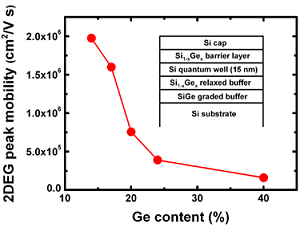 |
|
Figure 1. Electron density dependence of the 2DEG mobility for the sample with Si0.86Ge0.14 relaxed buffer layer measured at T = 0.3 K. The maximum value of 2DEG mobility of the Si0.86Ge0.14 sample reaches 2 × 106 cm2/V s at the electron density of 1.4 × 1011 cm-2. |
Figure 2. The 2DEG peak mobility as a function of Ge concentration in the relaxed buffer layer. The inset demonstrates the SiGe/Si/SiGe heterostructure schematically. |
Threshold voltage controlled by gate area and gate recess in inverted trapezoidal trigate AlGaN/GaN MOS-HEMTs with PEC and PEALD oxides
Professor
Lung-Han Peng
Graduate Institute of Photonics and
Optoelectronics, National Taiwan University
臺灣大學光電所 彭隆瀚教授
An enhancement-mode, AlGaN/GaN
inverted trapezoidal trigate MOS-HEMT wrapped with double-layered oxides, i.e., PEC-grown Ga2O3/(Al,Ga)2O3 and PE-ALD Al2O3, was demonstrated to exhibit positive Vth = 1.2V with current on/off ratio of 108 and sub-threshold swing of 160mV/dec. HRTEM analysis revealed trapezoid-shape channel sidewalls due to crystallographic wet chemical etching by using molten KOH, and a reaction rate-limited process at which the outer surfaces of the nonpolar/semipolar GaN facets are converted into crystalline α-Ga2O3 passivation layers with preferential growth of (003) α-Ga2O3 upon the c-plane of GaN. From DC characteristics analysis of diverse gate recess depths and different gate areas of fabricated devices, we suspected that there is negative polarization in the interface of double-layer gate oxide and barrier to compensate the strong polarization charge induced by AlGaN/GaN heterostructure, and hence, to lead to higher threshold voltage than other HEMTs without gate oxide. These observations can be ascribed to combined effects of (a) interfacial negative space charge of 3.2 μC/cm2 in the gate-recessed device to partially compensate the spontaneous charge, and (b) side-wall passivation to preserve the high mobility channel. It relaxes the constraint of using nanometer scale channel width to achieve positive value of Vth and results in a cut-off frequency of unity current gain/power gain at fT/fmax = 9/36GHz at gate length/width of LG /Lw = 250 /360nm.
|
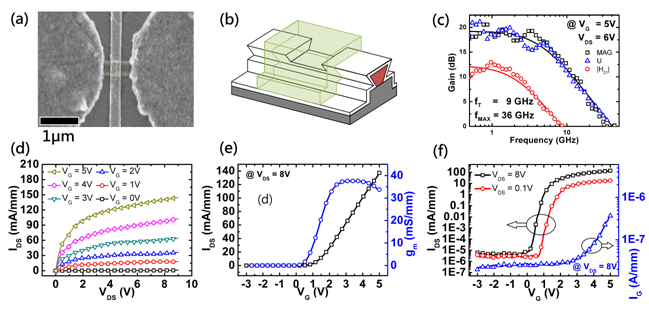 |
|
Fig. 1 (a) Top-view SEM micrograph of inverted trapezoidal trigate AlGaN/GaN MOS-HEMT with gate recess, (b) 3D structural diagram of this device, (c) the fT and fMAX plot corresponding to LG=250nm E-mode AlGaN/GaN inverted trapezoidal trigate MOS-HEMT, and DC measurements for (d) IDS-VDS family curves, (e) transfer characteristics and transconductance curve in linear-scale, (f) transfer characteristics of IDS-VG in log-scale and IG-VG gate leakage current measured in a three-terminal configuration. |
Ref: Po-Chun Yeh, Yun-Wei Lin, Yue-Lin Huang, Jui-Hung Hung, Bo-Ren Lin, Lucas Yang, Cheng-Han Wu, Tzu-Kuan Wu, Chao-Hsin Wu, and Lung-Han Peng," Threshold voltage controlled by gate area and gate recess in inverted trapezoidal trigate AlGaN/GaN MOS high-electron-mobility transistors with photoenhanced chemical and plasma-enhanced atomic layer deposition oxides", Applied Physics Express, 8, 084101, 2015.
|
 |
| |
|
|
|
 |
|
| |
|
 |
論文題目:基於寬頻晶體光纖元件之功能性光學同調斷層掃描術之研究
姓名:何端書 指導教授:黃升龍教授
| 摘要 |
|
光學同調斷層掃描(OCT)除了用來進行結構性的檢測外,亦可用來分析材料之光學特性。利用本實驗室研發的晶體光纖光源(圖一),具有寬頻響應之OCT系統可被建立。此OCT系統具有高縱向解析度(於玻璃中之縱向解析度達1微米),足以分析微米尺度膜層之特性(圖二),而經由OCT獲得之數據,除了可準確分析膜層厚度外,亦可量得材料之折射率與消光係數於光源頻寬(近95奈米)內之頻譜分佈。此技術具有高空間解析度,以及量測結果不易受到樣本內未知的結構影響之優點。
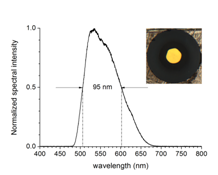 |
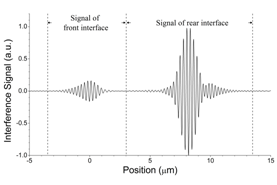 |
|
圖一 |
圖二 |
|
論文題目:頻率選擇平面於電磁干擾屏蔽、雙頻和可調變結構之新穎設計
姓名:黃凡城 指導教授:邱奕鵬教授
| 摘要 |
|
本論文提出新式圓形縮小化結構頻率選擇平面、非常接近雙頻頻率選擇平面以及可調變操作頻率的頻率選擇平面。
新式圓形縮小化結構頻率選擇平面中提出圓形結構縮小化的設計(如圖一),且同時具有其他優點,如對不同極化和入射角度都有穩定結果。非常接近雙頻頻率選擇平面(如圖二)的主要特點在於兩個操作頻段可以非常接近,可以更有效的利用頻寬。可調變操作頻率的頻率選擇平面則是提出了一個簡單可以調整操作頻率的方式。
研究中首先會先利用數值模擬軟體HFSS(finite element method)進行S參數的分析,觀察不同入射角度及極化的頻率響應參數,再製作頻率選擇平面原型以實驗量測驗證模擬結果。
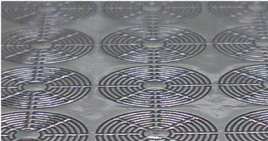 |
 |
|
圖一、圓形結構縮小化頻率選擇平面 |
圖二、非常接近雙頻頻率選擇平面 |
|
|
|
 |
|
 |
|
| |
|
 |
—
資料提供:影像顯示科技知識平台 (DTKP, Display Technology
Knowledge Platform) —
—
整理:林晃巖教授、廖瑋珅 —
光動能機器人
超微小機器人已經被提出將來可應用於體內藥品輸送及進行微手術。這樣的設備理想上是以無線傳輸的方式驅動。為了實現這項技術已經有數種方法被探討,包含使用凡德瓦力(van der Waals)和毛細現象(capillary effects)以及人造肌肉(artificial muscles)。然而要達成微米尺寸之微小化卻擁有足夠的力量以驅動機器人是一大挑戰。
現在Hao Zeng和在義大利和波蘭的同事發表了光驅動之顯微光行者(walkers) (Adv. Mater. 27, 3883–3887, 2015),此裝置尺寸為60 × 30 × 10立方微米(μm3)和四個圓錐形腳長約10微米(如圖1),最遠可跳1公分遠。
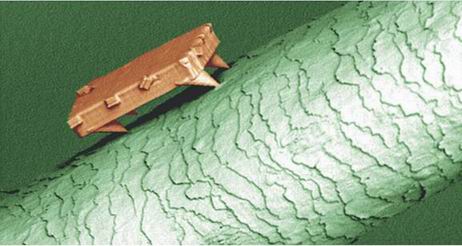 |
|
圖1、光能行走者之照片 |
此團隊展示一種液晶彈性體(liquid crystalline elastomer, LCE),當使用波長532奈米的雷射加熱到100 °C時,彈性體可以有20%的收縮(如圖 2),這項能力可以被用來驅動經過適當設計的元件腳部。有趣的是,該驅動可以在高達1.8千赫(kHz)的頻率下完成。
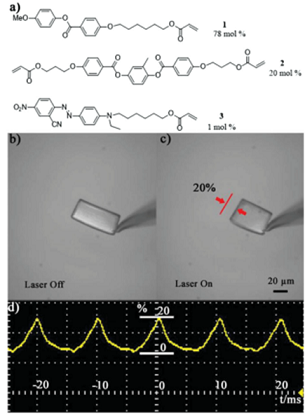 |
|
圖2、液晶單體成分和LCE致動響應(actuating response)圖。(a)實驗用分子結構;(b)玻璃上尺寸60 × 30 × 10 µm3 之LCE致動器;(c)藉由聚焦雷射加熱至100°C時,LCE之收縮情況;(d)相同LCE結構,以100赫茲532奈米雷射觸發情況。 |
在文章裡其中一個作者Diederik Wiersma解釋,此系統可被視為是一個微米尺寸機器人(Robot),其優點是可以只藉由吸收環境光而獲得能量。對於顯微機器人的能量控管一直是一個困難的議題,因為沒有任何電池可以做到這麼小的尺寸。Wiersma說,「我們以光能解決這個問題。此機器人能走、旋轉和跳躍,成為了最小能行走的人造物(artificial creature),比目前已知的地球上動物都還小。」
Wiersma指出他們團隊的化學家和物理學家為了這個裝置一起工作近五年。工作涉及到了材料科學和光學以及如何使如此微小的裝置移動。Wiersma解釋:「當你要設計微米等級元件時,物理學上就會變得非常特殊。例如,其黏著力會變得相當的巨大,正確地說,機器人必須利用腳趾的尖端處移動。」
Wiersma指出此概念有助於觀察表面的力量及微米尺寸元件的運動,如圖3;而另一個有趣的研究面向是,微米機器人不僅可以藉由光能驅動,也可以影響到他們外在環境的光學特性,因此開啟了數個研究領域,特別是和不同光學結構的整合。
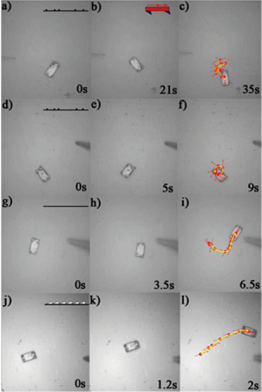 |
|
圖3、表面運動情形。使用雷射(532奈米、50赫茲,每平方毫米10瓦)觸發尺寸60微米的顯微光行者。(a-c)隨機走動在鍍上聚酰亞胺(polyimide, PI)的玻璃表面上;(d-f)單腳固定在鍍PI玻璃面上旋轉;(g-i)自己重新定位到乾淨的玻璃面上移動;(j-l)沿著垂直光柵槽圖案(grating groove pattern)方向移動。 |
|
參考資料: |
1. David Pile,
Micro-optics: Light robots, Nature Photonics 9, 426 (2015).
DOI: 10.1038/nphoton.2015.113, Published online 30 June 2015
http://www.nature.com/nphoton/journal/v9/n7/full/nphoton.2015.113.html
2. Hao Zeng, Piotr Wasylczyk, Camilla Parmeggiani,
Daniele Martella, Matteo Burresi, Diederik Sybolt Wiersma, Light-Fueled Microscopic Walkers, Advanced Materials 27, 3883–3887 (2015).
DOI: 10.1002/adma.201501446
http://onlinelibrary.wiley.com/doi/10.1002/adma.201501446/abstract
|
| |
|
|
|
|
|
|
|
|
|
 |
|
 |
|
|
|
 |
|
 |
|